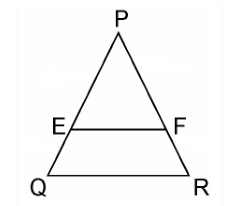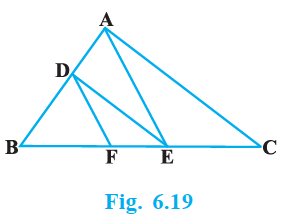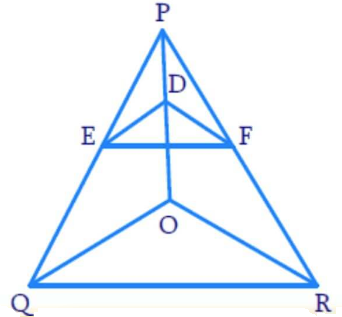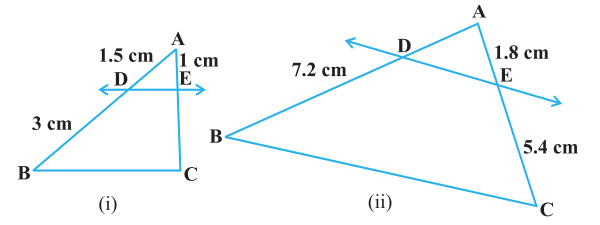E and F are points on the sides PQ and PR respectively of a Δ PQR.
For each of the following cases, state whether EF || QR :
(i) PE = 3.9 cm, EQ = 3 cm, PF = 3.6 cm and FR = 2.4 cm
(ii) PE = 4 cm, QE = 4.5 cm, PF = 8 cm and RF = 9 cm
(iii) PQ = 1.28 cm, PR = 2.56 cm, PE = 0.18 cm and PF = 0.36 cm
Given, in ΔPQR, E and F are two points on side PQ and PR, respectively. See the figure below

(i) PE = 3.9 cm, EQ = 3 cm, PF = 3.6 cm and FR = 2.4 cm
by using Basic proportionality theorem
find $\dfrac{PE}{EQ}$ and $\dfrac{PF}{FR}$
$\dfrac{PE}{EQ} = \dfrac{3.9}{3} = \dfrac{39}{30} = \dfrac{13}{10} = 1.3$
$\dfrac{PF}{FR} = \dfrac{3.6}{2.4} = \dfrac{36}{24} = \dfrac{3}{2} = 1.5$
$\dfrac{PE}{EQ} \neq \dfrac{PF}{FR}$ , EF not Parallel QR
(ii) PE = 4 cm, QE = 4.5 cm, PF = 8 cm and RF = 9 cm
by using Basic proportionality theorem
find $ \dfrac{PE}{EQ}$ and $\dfrac{PF}{FR}$
$\dfrac{PE}{QE} = \dfrac{4}{4.5} = \dfrac{40}{45} = \dfrac{8}{9}$
$\dfrac{ PF}{RF} = \dfrac{8}{9}$
$\dfrac{PE}{QE} = \dfrac{PF}{RF}$ , EF is Parallel to QR.(iii) PQ = 1.28 cm, PR = 2.56 cm, PE = 0.18 cm and PF = 0.36 cm
by using Basic proportionality theorem
find $ \dfrac{PE}{EQ}$ and $\dfrac{PF}{FR}$
EQ = PQ – PE = 1.28 – 0.18 = 1.10 cm
FR = PR – PF = 2.56 – 0.36 = 2.20 cm
So, $\dfrac{PE}{EQ} = \dfrac{0.18}{1.10} = \dfrac{18}{110} = \dfrac{9}{55}$…………. (i)
$\dfrac{PE}{FR} = \dfrac{0.36}{2.20} = \dfrac{36}{220} = \dfrac{9}{55}$………… (ii)
$\dfrac{PE}{EQ} = \dfrac{PF}{FR},$ EF is parallel to QR.





